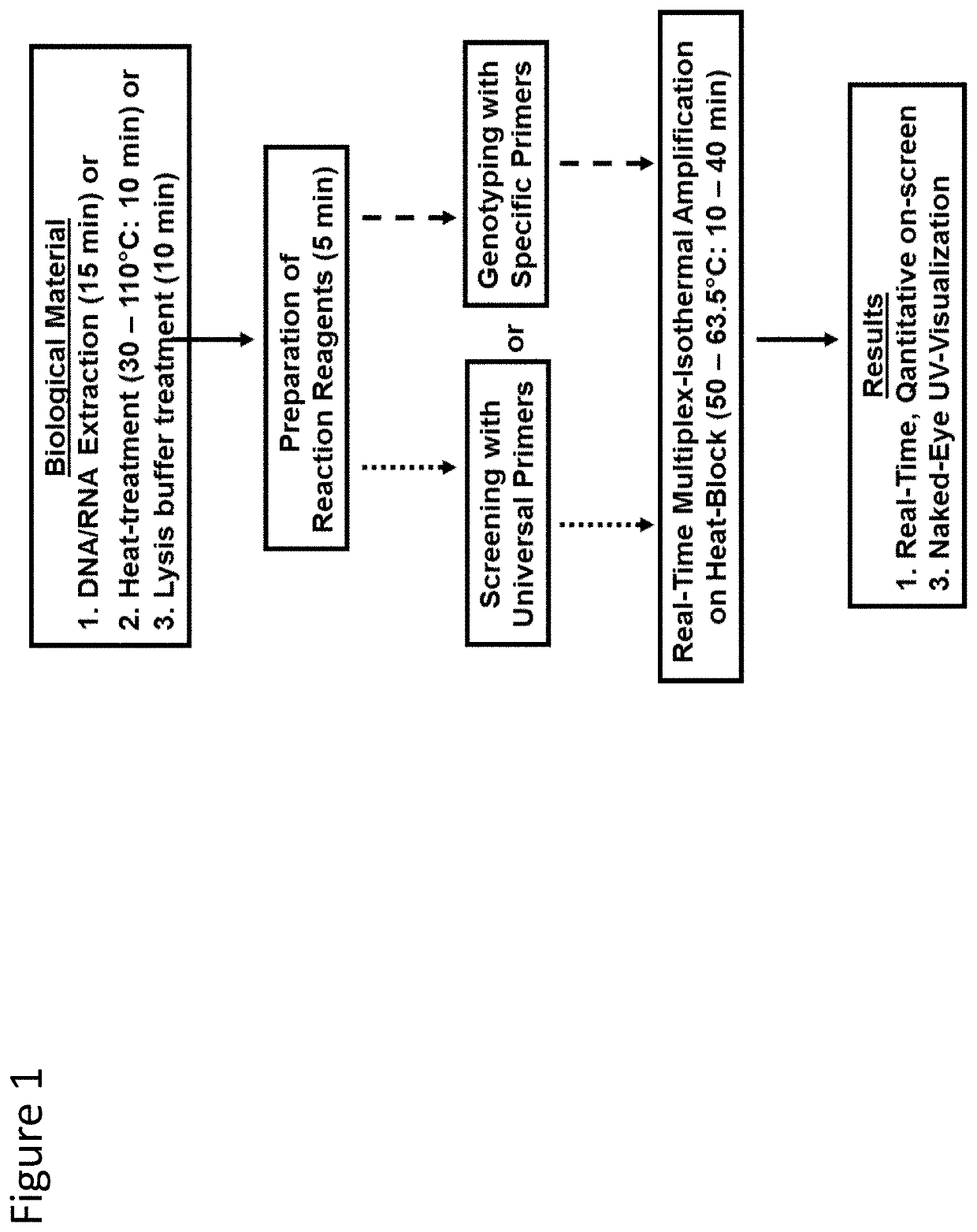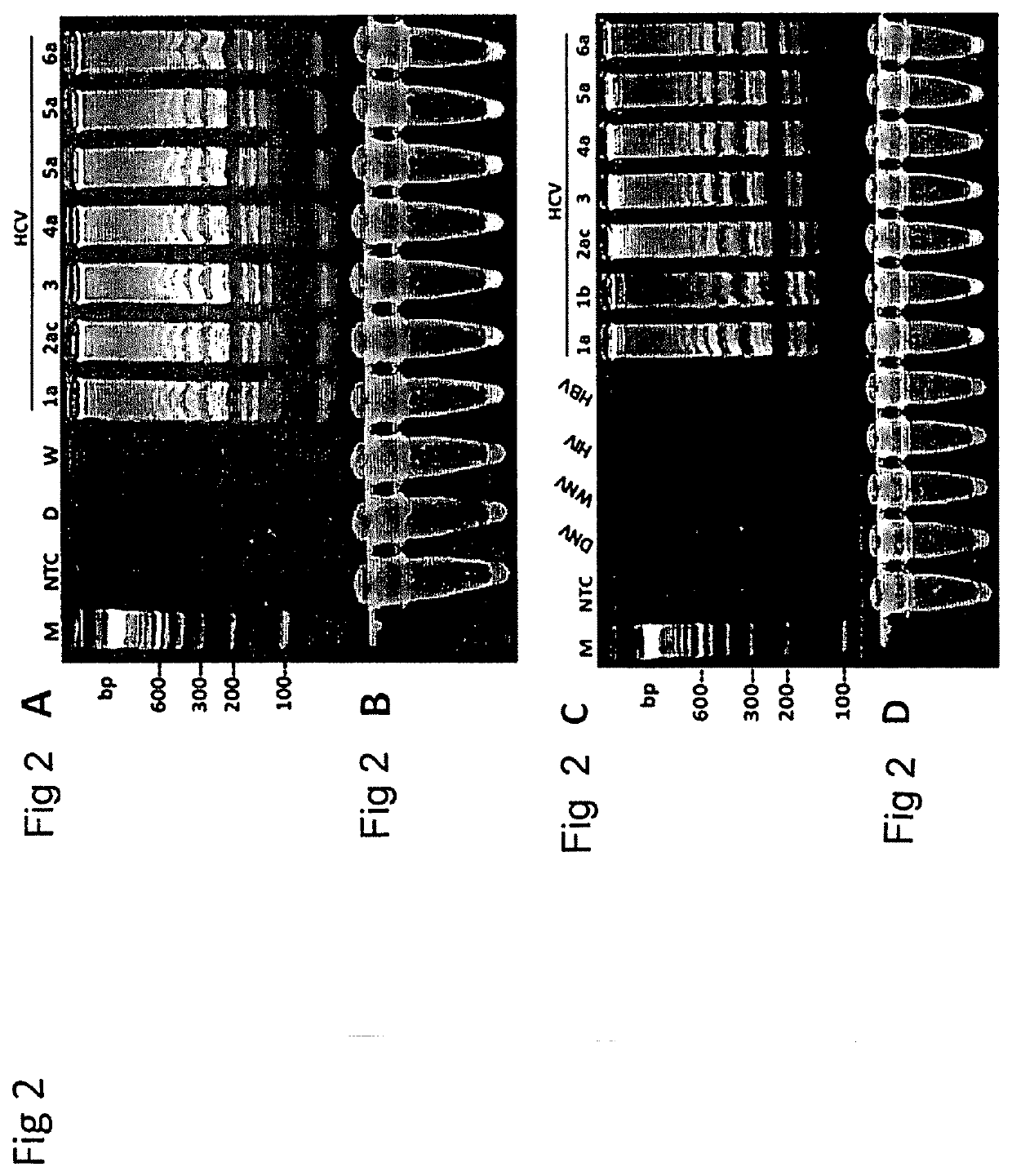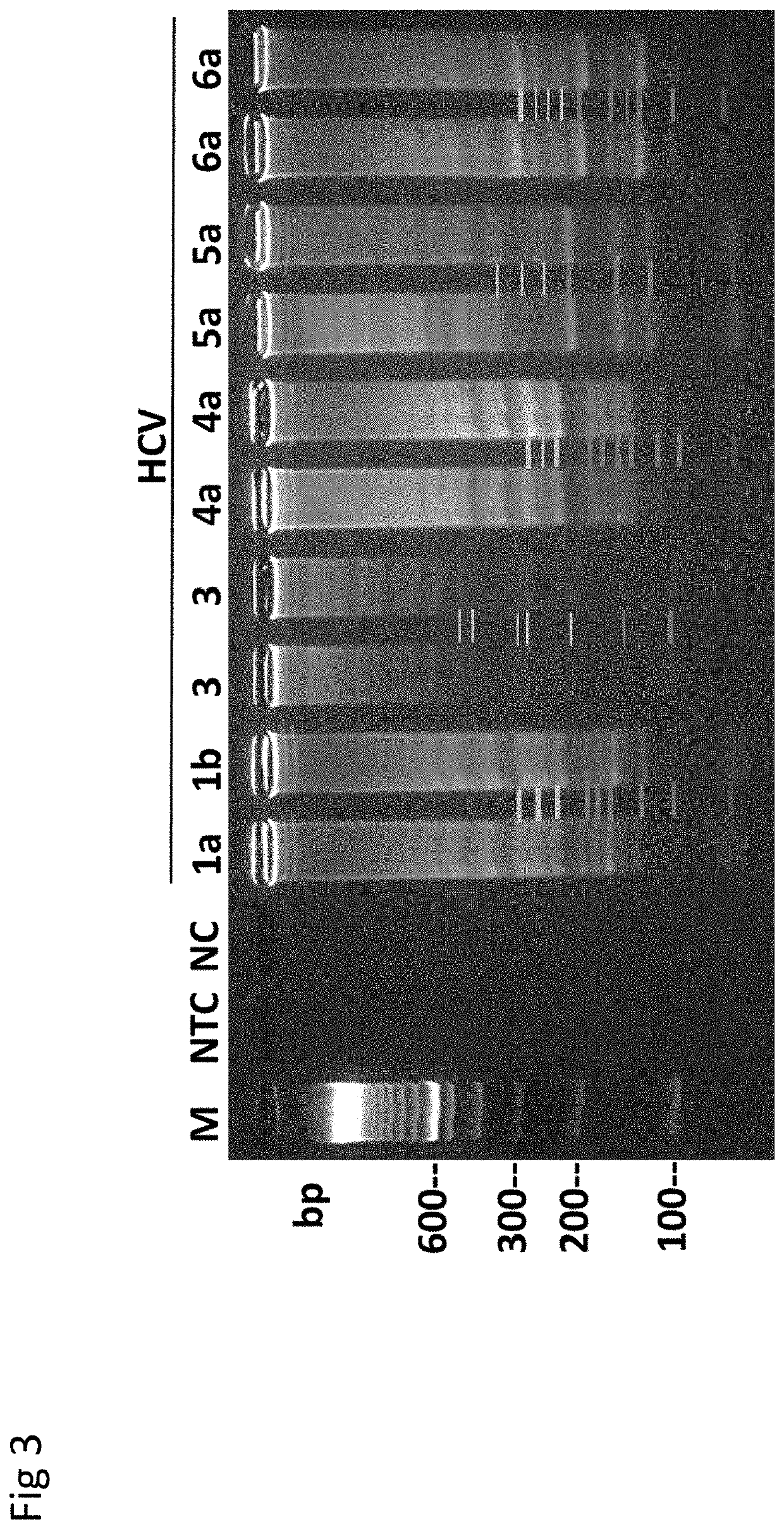Methods for real-time multiplex isothermal detection and identification of bacterial, viral, and protozoan nucleic acids
a technology of which is applied in the field of real-time multiplex isothermal detection and identification of bacterial, viral and protozoan nucleic acids, can solve the problems of rigid and inflexible isothermal platforms, inability to quickly detect and identify pathogens, and inability to fast simultaneous quantification of pathogen load in infected people, etc., to achieve the effect of flexible and versatil
- Summary
- Abstract
- Description
- Claims
- Application Information
AI Technical Summary
Benefits of technology
Problems solved by technology
Method used
Image
Examples
example 1
Assay Reagents
[0166]Sets of primers were designed for real-time multiplex (RT)-LAMP assays for HBV, HCV, HIV, WNV, EBOV, MARV, HBV, CHIKV, MERS CoV, SARS CoV, PAB19, CMV, JEV, MTB, HEV, DENV, YFV, LFV, LE, ZKV, TRY, and / or PLM (see Table 1). Any of the F3, R3, FIP, RIP, LF, LR primer for each set may include a complementary stem-attached fluorophore and quencher at the 5′and 3′ ends or at the 3′ and 5′ ends, respectively; wherein “F”=fluorophore, “Q”=quencher, and stem of complementary nucleotides (see FIG. 14).
TABLE 1(RT)-LAMP nucleotide primer sequencesOligoSEQ IDPathogenNameOligonucleotide Sequence (5′- 3′)NO.HCVN5F3CATAGTGGTCTGCGGAACC1N5R3CACGGTCTACGAGACCTCC2N5FIPCGGGCATTGAGCGGGTTTATCCTTTTGGTGAGT3ACACCGGAATTGCN5RIPCGCGAGACTGCTAGCCGAGTTTTTAGCACCCTA4TCAGGCAGTACN5LFAAAGGACCCGGTCATCCC5N5LRGTCGCGAAAGGCCTTGTG6N6F3aTAGTGGTCTGCGGAACCG7N6R3aCACCGTCTACGAGACCTCC8N6FIPaGGCATTGAGCGGGTTTGATCCATTTTGAGTACA9CCGGAATTGCCAN6RIPaGCAAGACTGCTAGCCGAGTAGCTTTTCACTCGC10AAGCACCGTATN6LFaAAAGGACCCGGTCGTCC11N...
example 2
[0168]RT-LAMP Assay for Rapid Detection and Genotype-Identification of Hepatitis C virus 1-6.
[0169]The subject matter of this example is included in Nyan and Swinson (International Journal of Infectious Diseases; DOI: http: / / dx.doi.org / 10.1016 / j.ijid.2015.12.002) that is referenced in part.
Introduction
[0170]Hepatitis C virus (HCV) is a single-stranded RNA virus of the Flaviviradae family (Moratorio et al., Virol J. 4: 79, 2007). Transmitted through modes including injection drug use (IDU), contaminated needle-stick injuries, and unsafe blood transfusion, infection with HCV may lead to chronic-active hepatitis and hepatocellular carcinoma (Ghany et al., Hepatology 4:1335-1374, 2009; Liang et al., Ann. Int. Med. 132:296-305, 2000; NIH Consensus Statement on Management of Hepatitis C; NIH Consens. Sci. Statements 19:1-46, 2002)Approximately 185 million people are infected with HCV worldwide, with developing countries of Sub-Saharan Africa, Asia, North and South America, and the Middle ...
example 3
Real-Time Quantitative Isothermal Multiplex Assay for Pathogen Detection
[0184]The subject matter of this example is included in Nyan and Swinson (Nature Scientific Reports; doi:10.1038 / srep17925) that is referenced in part.
Introduction
[0185]The global emergence or re-emergence of a plethora of bacterial, viral, and parasitic pathogens with outbreaks of virulent infections have challenged the diagnostic capabilities of health care systems globally, mainly in resource-limited environments (Baize et al., N Engl J Med. 371: 1418-1425, 2014; Duda et al., J Int AIDS Soc. 17:19045, 2014). This have since underscored the need for simple, but efficient diagnostic tools that would enable rapid detection, quantitation, and simultaneous identification of pathogens, particularly those presenting similar on-set clinical symptoms. Such differential diagnostic tools would enable health care workers to institute the requisite measures including isolation and timely therapeutic interventions. Hepatit...
PUM
| Property | Measurement | Unit |
|---|---|---|
| temperature | aaaaa | aaaaa |
| temperature | aaaaa | aaaaa |
| pH | aaaaa | aaaaa |
Abstract
Description
Claims
Application Information
 Login to View More
Login to View More - R&D
- Intellectual Property
- Life Sciences
- Materials
- Tech Scout
- Unparalleled Data Quality
- Higher Quality Content
- 60% Fewer Hallucinations
Browse by: Latest US Patents, China's latest patents, Technical Efficacy Thesaurus, Application Domain, Technology Topic, Popular Technical Reports.
© 2025 PatSnap. All rights reserved.Legal|Privacy policy|Modern Slavery Act Transparency Statement|Sitemap|About US| Contact US: help@patsnap.com



